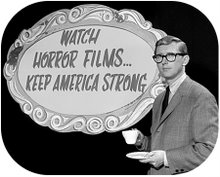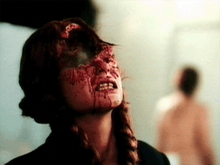When people say there are no guilty pleasures, I appreciate the sentiment behind that position but respectfully disagree. I'm not talking about the embarrassment and shame you feel when a favorite artist or entertainer or a piece of art or entertainment that you enjoy is deemed uncool by your peer group or someone whose taste you admire. Those of us consumed by the world of film, music, literature, art, pop culture, and counterculture tend to have strong opinions and aesthetics and can be unnecessarily harsh when debating those opinions and subscribing to those aesthetics, but if you're not a passive consumer, you deserve to enjoy what you enjoy without guilt, shame, or embarrassment. What you enjoy should still be open to fair criticism, but you shouldn't have to hang your head in shame for getting something worthwhile out of it.
No, the guilty pleasures I'm talking about are the ones in which those feelings of embarrassment and shame are truly deserved. I'm talking about those cursed objects you enjoy that you know, deep in your soul, deep in your heart, deep in your gut, are total trash. When I watched a few seasons of Married at First Sight, I didn't feel good about it, and I was right to feel that way. GUILTY! When I watched every Saw movie, I could have been doing anything else with my time and it would have been an improvement. GUILTY!! When I watched Maury Povich's and Jerry Springer's talk shows, I was not communing with the godhead. GUILTY!!!
Sitting near the top of my guilty pleasure pile is the vigilante vs. street punks revenge-killer movie, a staple of the 1970s and '80s in which a usually white, usually male private citizen living a decent life is driven to murder by a multicultural gang of lawless street maniacs who have murdered (and sometimes raped) the citizen's family or favorite neighborhood shopkeeper. These movies, excepting the few that are skillfully ambiguous and complex like Ms. 45, are mostly indefensible from a moral, political, and aesthetic standpoint (or at least from the morals, politics, and aesthetics that I hold). Be afraid, these movies say. Be afraid of black people, Latino people, punk rockers, young people. Be afraid of cities. These guys all want to rape your wives and daughters. They want to rob you. They want to kill you all. And they're everywhere in the city. Every city. Afraid now? OK, now it's time to get mad and get revenge. I know you're too much of a coward to be a vigilante, but you can take your fears and your anger and let Charles Bronson (or a Charles Bronson type) be your fantasy surrogate. Feeling better now? OK, time to vote for guys who want to do something about it!
You can trace elements of the current political shit soup United States residents are swimming in back to 1974's Death Wish, the granddaddy of the late 20th century vigilante movie. That movie's success, leading to scores of imitations, tributes, and sequels, became an important dream-text for the right-wing male, and its influence lives on in the still-prevalent conservative fantasy/fear of cities as crime-ridden hellholes in need of red-blooded, gun-slinging macho justice free of bureaucratic red tape and soft-on-crime liberal governance despite the fact that violent crime has dramatically decreased in nearly every major American city since the early '90s. Even when the crime rate was much higher in the '70s and '80s, the reality was far from the nonstop free-for-all of lawless violence these movies grossly exaggerated. I regularly get a laugh from right-wing grifters and their gullible followers depicting the downtown of my city of residence, Austin, Texas, as a nightmarish no-man's-land controlled by gangs of violent homeless people. Most of the homeless people are not violent, and most of them are homeless because of your policies, motherfuckers. I'm there regularly and it's still no crime-ridden hellhole despite social media posts to the contrary. Is this also happening in your city? Thank Death Wish.
And yet. And yet, I still love these damn movies. Every time I caught a vigilante movie on TV as a kid, it felt like Christmas morning. They were so exciting! Every gang had its own crazy thing going on, with wild fashions and hairstyles and weapons. One villain was exciting enough, but five (or more) villains terrorizing neighborhoods? That shit rocked! These movies had grit and atmosphere, and their settings presented a shadow world of depravity, insanity, and debauchery. I was hooked. As a small-town kid who was simultaneously afraid of the big bad outside world and impatient to take part in it, I was both seduced and repelled by the seedy vibrancy of night-time city life as depicted in these films.
After seeing all the success the original film's imitators were cashing in on, the major independent production company Cannon Films bought the Death Wish rights and decided to crank out some sequels. Cannon was a wild company that specialized in both lowbrow and highbrow good times, making dozens of drive-in/exploitation/b-movies, soft-core sex movies, ninja movies, Chuck Norris action movies, and Breakin' and Breakin' 2: Electric Boogaloo, as well as bankrolling movies by Jean-Luc Godard (King Lear), Andrei Konchalovsky (Shy People and Runaway Train), Jerry Schatzberg (Street Smart), and John Cassavetes (Love Streams). We need a Cannon Films of the 2020s, and, no, I'm not talking about A24, you weird young people who love brands.
Getting Charles Bronson back on board as Paul Kersey was the beginning of a repeat of the original's ingredients. Michael Winner, director of the first film, came back for round two at Bronson's insistence, replacing Cannon exec Menahem Golan, who coproduced. Continuing the tradition of having an extremely talented but unlikely musician scoring the film, Jimmy Page wrote the music for this round of death wishing, following in the footsteps of the first film's composer, Herbie Hancock. The first film's New York City location has been swapped for Los Angeles, but both cities are swarming with crime. Robin Sherwood takes over the role of Paul's daughter Carol from Kathleen Tolan but has an equally rough go of it from the street punks. Continuing the accidental tradition of one of the street punks becoming a big star later, Laurence Fishburne is one of their number (Jeff Goldblum was one of the bad guys in the first film).
Seven years after the dark events of part one, architect Paul Kersey (Bronson) has moved from New York to Los Angeles. He's living a happy life again. He's a success at work, has a news radio reporter girlfriend, Geri (Jill Ireland, Bronson's real-life wife, whose levelheaded anti-vigilante personality serves here to give the film some plausible deniability that it's just pro-vigilante propaganda), and a personal chef and housekeeper named Rosario (Silvana Gallardo), and he's still close with his daughter Carol (Sherwood), though she has remained mute since the first film's attack and has only recently begun saying a few words with the help of a therapist. Taking Geri and Carol out for some ice cream, Kersey walks by a gang of street weirdos who target him for a mugging. The silly-named gang is made up of the shaved-eyebrow/buzzcut with long hair in the back/Jesus-loving psycho Stomper (Kevyn Major Howard), Cutter (Fishburne, in peak new wave style), Jiver (Stuart K. Robinson), the oddly monikered Punkcut (E. Lamont Johnson), who does not have a punk cut but does otherwise dress somewhat punkily, and the hulking Nirvana (Thomas F. Duffy). (These names have much more flavor than the street punks in the first movie, who are billed as Freak 1, Freak 2, and Spraycan). Odd trivia fact: the two actors in the evil gang who are now deceased, Howard and Johnson, both died on Valentine's Day, Johnson in 1984 from AIDS and Howard just last week from a respiratory illness.
After Kersey gets his wallet lifted by the punks, ruining his ice cream plans, he chases them down and nabs one of them, Jiver, who catches a classic Chuck Bronson ass-kicking. Vowing revenge, the gang drive to the address on Kersey's wallet in their creepy van. Kersey is out with Carol, but, in a horrible and degrading scene, Rosario is gang-raped and killed. When Kersey and Carol return home, the gang knocks Kersey out and kidnaps Carol. The controversial rape scene was considerably censored for theatrical release but has been restored on recent video and streaming copies. I hate it. Winner seems to be getting his jollies from the scene, which goes on for an interminable length, with the camera leering at Gallardo's nude body and the faces of the men getting off on her torture and Winner directing her to crawl on all fours down the hallway before collapsing.
Winner claims he was just trying to show the horrendous reality of rape as a crime without any sugarcoating, but the film seems to take a sadistic glee in her suffering and vulnerability. I'm not alone. The film's original cinematographer quit in disgust before the scene was shot, the screenwriter says there were no rapes in his screenplay and that Winner added them "to get his rocks off," Bronson said the scene made him sick when he saw the finished film, Fishburne says he hated acting in the scene and thought it was too much, and Gallardo herself, who otherwise has kinder things to say about Winner than a lot of his collaborators and detractors, felt he took things too far and that the production's still photographer kept taking pictures of her while she was nude after Winner had said cut and before she could be covered up. I'm no prude or lover of censorship, but I hate rape scenes that serve no purpose other than showing that a character is a bad person or allowing filmmakers and audiences to get off on seeing a woman being assaulted.
I was down on Death Wish II during this scene and a shorter scene with an assault on the kidnapped Carol shortly afterward, though her death scene is pretty spectacular (it was also censored in the theatrical release). It's not enough to save the movie, but the rest of Death Wish II is considerably more interesting as a time capsule of skid row Los Angeles in the early 1980s. Of course, Kersey gets revenge on the gang one-by-one, and he rents a room in a downtown flophouse to surveil the night life until he nabs his prey. I like this chunk of the movie, as stupid and regressive as it is, because it's got a lot of visual grit and flavor, with plenty of local color from the location shooting and the extras and bit players. Vincent Gardenia even reprises his role as Det. Frank Ochoa in this portion of the film, sent from New York to LA on NYPD's suspicion that Kersey is at it again. He's always a fun guy to watch, even when he's returning to the well in a cash-grab sequel.
What else can I say? If you've seen one of these movies, you know the drill. Death Wish II has a lot of ugliness in its soul and is much more narratively clumsy than the first movie, which, politics aside, is a well-made piece of entertainment, but I can't deny its satisfying early '80s time-capsule pull or the shameful fact that I like regressive vigilante exploitation movies. I can't help it. I just wish they hadn't influenced decades of crime policy and sensationalist media propaganda.















1 comment:
Great writing and fun to read as usual!
Post a Comment